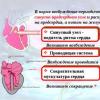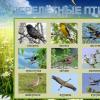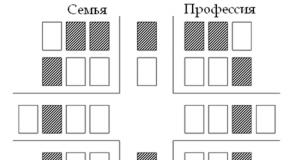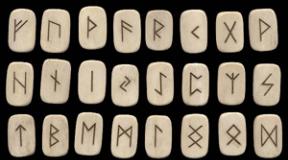Antagonists of curariform drugs. Muscle relaxants (curariform drugs). How muscle relaxants work
Page 1 of 3
Peripheral muscle relaxants (cure-like drugs)
Peripheral muscle relaxants block the H-cholinergic receptors of skeletal muscles and cause relaxation of skeletal muscles (muscle relaxation). According to the mechanism of action, curariform agents can be divided into:
1) muscle relaxants of the peripheral action of antidepolarizing (competitive) type of action, which block H-cholinergic receptors of skeletal muscles, prevent the interaction of H-cholinergic receptors with acetylcholine and depolarization of the muscle plate followed by its repolarization (tubocurarine, etc.);
2) muscle relaxants of the peripheral action of the depolarizing type of action, which cause persistent depolarization of the muscle plate, which prevents the onset of repolarization (ditilin, etc.);
3) muscle relaxants of the peripheral action of the mixed type of action, giving antidepolarizing and depolarizing effects (dioxonium, etc.).
Muscle relaxants cause muscle relaxation in a specific sequence: facial muscles of the face, muscles of the limbs, vocal folds, trunk, diaphragm and intercostal muscles. Paralysis of the diaphragmatic and intercostal muscles can lead to the death of the patient due to respiratory arrest, if the patient is not transferred to mechanical ventilation in time.
According to the duration of action, muscle relaxants can be divided into 3 groups: 1) short acting(5-10 min) - suxamethonium (ditilin); 2) medium duration of action (20-40 minutes) - tubocurarine chloride, pancuronium bromide (pavulon), pipcuronium bromide (arduan), etc.; 3) long acting(60 minutes or more) - pancuronium bromide, pipcuronium bromide (large doses).
All curariform substances are used in surgical practice to relax muscles during operations (together with drugs for anesthesia), they are used to reduce dislocations, to relieve convulsive conditions(tetanus). Muscle relaxants of peripheral action are contraindicated: for myasthenia gravis, liver and kidney diseases; use with great caution in old age. In case of an overdose of antidepolarizing drugs, anticholinesterase agents are used as physiological antagonists. In case of an overdose of drugs of a depolarizing type of action, anti-linesterase agents can only enhance their effect; in this case, citrated blood containing the enzyme pseudocholinesterase, which destroys ditilin, is injected.
TUBOCURARIN CHLORIDE- a curariform drug of an antidepolarizing type of action. Tubocurarine chloride is used intravenously at 0.4-0.5 mg / kg body weight. Release form tubocurarine chloride: 1% solution in ampoules of 1.5 ml, containing 15 mg of the drug in 1 ml. List A
An example of a tubocurarine chloride recipe in Latin:
Rp .: Sol. Tubocurarin! chloridi 1% 1.5 ml
D. t. d. N. 6 im ampull.
S. Administer intravenously at the rate of 0.4-0.5 mg / kg of the patient's body weight.
DIPLACIN- has an anti-depolarizing type of action. Diplacin is administered intravenously as a 2% solution. Diplacin release form: ampoules of 5 ml of 2% solution. List A.
An example of a diplacin recipe in Latin:
Rp .: Sol. Diplacini 2% 5 ml
D. t. d. N. 10 in ampull.
S. In a two-hour operation, inject intravenously 20-30 ml of a 2% solution.
MELLIKTIN- a drug of an antidepolarizing type of action. Melliktin is used to treat diseases accompanied by increased muscle tone (parkinsonism, etc.). Melliktin is prescribed orally for 3-8 weeks with repeated courses every 3-4 months. Contraindications to the use of melliktin are common for muscle relaxants. The release form of melliktin: tablets of 0.02 g. List A.
An example of a melliktin recipe in Latin:
Rp .: Tab. Mellictini 0.02 N. 50
D. S. 1 tablet 2-4 times a day.
Muscle relaxants, selectively affecting the H-cholinergic receptors of neuromuscular synapses, cause reversible paralysis of skeletal muscles. The drugs of this group are used in anesthesiology.
Curare - arrow poison of the Orinoco and Amazonian Indians, a mixture of juices and tree extracts Strychnos toxifera(toxiferins) and Chondro- dendron tomentosumwith the addition of snake venom. The active ingredient in curare is the alkaloid tubocurarine.
The localization of the action of curare was established in the experiments of Claude Bernard (1851) and Eugene Ventslavovich Pelikan (1857). One of the founders of experimental pharmacology, Claude Bernard, conducted the following research:
In the frog, the artery of the limb was ligated, and then curare was injected. In this case, paralysis of the entire musculature of the body occurred, except for the limb with a ligated vessel. This experience proves that curare does not depress the central nervous system, but acts peripherally.
One neuromuscular preparation was placed in a curare solution, the other in a physiological sodium chloride solution. Irritation of a nerve placed in a curare solution led to a contraction of a muscle that was in a saline solution. On the contrary, irritation of the nerve in saline was not accompanied by contraction of the muscle washed by the curare solution. Direct electrical stimulation of this muscle caused the usual contractile act.
Thus, it was found that curare does not disrupt the conduction of impulses along the motor nerves, does not change the function of muscle fibers, and inhibits the activity of neuromuscular synapses.
The use of muscle relaxants in anesthesiology began in 1942, when the Canadian anesthesiologists G. Griffig and G. Johnson used tubocurarine chloride for potentiated anesthesia. The safe use of muscle relaxants became possible only after the improvement of the technique of artificial lung ventilation.
The most active muscle relaxants have the structure of quaternary symmetric bisammonium compounds for infusion into a vein.
According to the mechanism of action, muscle relaxants are divided into two groups - antidepolarizing and depolarizing.
Antidepolarizing muscle relaxants (pachicurare)
Antidepolarizing muscle relaxants have rigid molecules with a distance between quaternary nitrogen atoms of 1.0 ± 0.1 nm. The composition of molecules includes hydrophobic aromatic and heterocyclic radicals (pahikurare - literally "thick curare", Greek. pachys - thick).
The mechanism of action of antidepolarizing muscle relaxants is competitive antagonism with acetylcholine in relation to the H-cholinergic receptors of skeletal muscles. Muscle relaxants block the anionic center of the receptors, and also form van der Waals bonds with the receptor sites surrounding the anionic center. The blockade of H-cholinergic receptors, stabilizing the resting potential in the end plate, causes flaccid paralysis of skeletal muscles. In high concentrations, muscle relaxants directly disrupt the conduction of open sodium channels in skeletal muscles.
Information about antidepolarizing muscle relaxants-quaternary amines (TUBOCURARIN-CHLORIDE, PIPEKURONIA BROMIDE, ATRAKURIA BESILATE, MIVACURIA CHLORIDE and others) are given in table. 18.1.
With the introduction of antidepolarizing muscle relaxants, skeletal muscles are paralyzed in a specific sequence. First, the external muscles of the eyes, middle ear, fingers and toes are relaxed, then the muscles of the face, neck, limbs, trunk, intercostal muscles, and last of all, the diaphragm. The restoration of skeletal muscle tone occurs in the reverse order.
Quaternary amines do not enter the central nervous system. It is known that the anesthesiologist Smith (S. Smith, 1947) experienced the effect of tubocurarine chloride in a dose that exceeded 2.5 times the therapeutic dose. After the introduction of tubocurarine into a vein, the subject did not experience analgesia, impairment of consciousness, memory, sensitivity, vision, hearing did not change breathing, and no EEG abnormalities were recorded.
Muscle relaxants-tertiary amines are less effective, do not cause paralysis of the respiratory muscles, and are well absorbed when taken orally. A representative of this group is a derivative of the larkspur alkaloid (delphinium) MELLIKTIN. "
Synergists of antidepolarizing muscle relaxants are drugs for anesthesia and drugs collectively called central muscle relaxants (sedative tranquilizers - sibazone, phenazepam; GABA receptor agonist type V - baclofen; central H-anticholinergic antagonist - midocalm *). These medicines oppress the basal ganglia, hippocampus, spinal cord.
The myoparalytic effect is also potentiated by means that prevent the release of acetylcholine from nerve endings - antibiotics of the aminoglycoside group, tetracycline, lincomycin, polymyxins, magnesium sulfate, local anesthetics.
Antagonists are reversible cholinesterase blockers with nicotine-like action - proserin, galantamine, quinotiline. They cause the accumulation of acetylcholine in the neuromuscular synapses, which displaces antidepolarizing muscle relaxants from their connection with H-cholinergic receptors. Decurarization is carried out when the ventilation volume reaches 20-30% of the normal volume. The action of most deblocking agents is shorter than that of muscle relaxants. This creates the danger of recurarization with the return of paralysis of the respiratory muscles.
Curare is the only type of arrow poison. Penetrating into the body of the animal, the poison generates stagnation of skeletal muscles, and the creature loses the ability to move (the meat of such animals is suitable for food, since the poison is poorly absorbed in the digestive tract). The most commonly used are tubocurarine chloride, ditilin, diplacin and other drugs listed below. Curariform agents differ in the mechanism and duration of exposure.
An excursion into history
In 1856, the famous French physiologist Claude Bernard determined that the poison blocks the transmission of excitation from the motor nerves to. In Russia, regardless of the same results were obtained by the popular forensic chemist and pharmacologist E.V. Pelikan. The main result of this category pharmacological preparations relaxation of skeletal muscles is considered. For this reason, they are called muscle relaxants (from the Greek myos - muscle, and Latin relaxatio - reduction) of the peripheral type of influence. It should be noted that the property of reducing the activity of structural muscles is possessed by numerous pharmaceutical substances that have a great effect on the central nervous system(central muscle relaxants), for example tranquilizers.
Mechanism of work
According to the mechanism of action, curariform agents should be divided into types:
- Antidepolarizing (competitive) type of exposure. They suppress the action of n-cholinergic receptors of skeletal muscles and prevent their excitation by acetylcholine, prevent the onset of muscle fiber depolarization. Tubocurarine, diplacin, meliktin, etc. immediately cause relaxation of muscle fibers.
- Depolarizing type of effect that activates the depolarization of the cell membrane, contraction of muscle fibers.
- A complex type of exposure, providing anti-depolarizing and depolarizing results (dioxonium, etc.). Muscle relaxants activate muscle relaxation in a specific sequence: facial muscles of the face, muscles of the limbs, vocal cords, body, diaphragm and intercostal muscles.
Classification

According to the duration of exposure, muscle relaxants should be divided into 3 categories:
- short-term exposure (5-10 minutes) - ditilin;
- medium duration (20-40 minutes) - tubocurarine chloride, diplacin, etc .;
- long-term exposure (60 minutes and more) - anatruxonium.
Curariform drugs include drugs that are listed below.
Tubocurarine chloride

It is used in anesthesiology as a muscle relaxant (a substance that soothes muscles), in traumatology for repositioning (combining) fragments and repositioning difficult dislocations, in psychiatry to prevent injuries during convulsive therapy in patients with schizophrenia, etc. An injection is made into a vein.
The effect of the substance is formed over time, as a rule, muscle relaxation occurs in 60-120 seconds, and the maximum effect begins in 4 minutes. The average serving for an adult is 20 mg, with relaxation lasting 20 minutes. Typically, 45 mg of the substance is used for an operation lasting more than 2 hours.
Unlike depolarizing muscle relaxants (for example, succinylcholine), it does not activate muscle fasciculations. Does not show hormonal effects.
Even at doses several times higher than the effective dose required for a 90% decrease in muscle contractility, it does not exhibit ganglion blocking, m-anticholinergic blocking and sympathomimetic effects.
Studies have shown that, with balanced anesthesia, the effective doses required for a 50% and 90% reduction in muscle contractility are 0.04 mg / kg, respectively.
A dose of 0.04 mg / kg guarantees 45 minutes of muscle relaxation during different treatments.
The maximum effect of pipcuronium bromide depends on the amount of the drug administered and begins after a couple of minutes. The result develops more rapidly with portions equal to 0.7 mg / kg. Subsequent dose increases will shorten the time required to obtain results and significantly increase the effect of pipcuronium bromide.

Ditilin
Injected directly into a vein. When performing an intubation procedure (inserting a tube into the trachea to embody artificial respiration) and for absolute muscle asthenia, a drug is administered at a dose of 2 mg / kg.
For prolonged relaxation of the muscles throughout the entire procedure, it is possible to inject medicine in small portions of 0.5-1.5 mg / kg. Secondary doses of ditilin function for a longer time.
Neurin and other anticholinesterase elements are in no way antagonists (elements with a reverse effect) in relation to the depolarizing effect of ditilin; on the contrary, suppressing the dynamics of cholinesterase, they lengthen and increase its effect.

In case of complications associated with the use of ditilin (prolonged respiratory suppression), an apparatus is used for support, and if necessary, blood is transfused, injecting cholinesterase in a similar way. It must be borne in mind that in large portions ditilin is capable of provoking a blockage, if an anti-depolarizing result is formed after a depolarizing effect.
For this reason, if after the final injection of ditilin, muscle relaxation does not pass for a long time (for half an hour) and breathing does not resume entirely, proserin or galantamine is injected intravenously after the preliminary introduction of atropine 0.6 milliliters of a 0.1% solution.
The list of substances can be continued for a long time. They are used only in a special institution, under the strict supervision of really qualified doctors, in prescribed doses and with the support of special equipment. Any deviation from the norm entails a grave consequence that can cost human life.
Dear Colleagues!
The debate about euthanasia has been going on for years. The discussion, from my point of view, is meaningless. The mechanism of action of drugs has been known for a long time, and it is foolish to discuss it. People who advocate the use of curariform drugs for euthanasia have little understanding of such concepts as compassion, humanity, medical ethics. I think the chest is easy to open. We need a market for these drugs, and they must be pushed by any means. But where money begins, humanity ends. Your opinion is important to us, and therefore we ask for your opinion; and those who consider themselves a doctor, sign a letter indicating their data.
Sincerely,
President of the Association of Veterinary Practitioners,
Honored Veterinarian of the Russian Federation,
Candidate of Veterinary Science
Sereda S.V.
OPEN LETTER TO THE VETERINARY COMMUNITY
TO A DOG - DOG'S DEATH?
EUTHANASIA IN TRANSLATION MEANS HAPPY DEATH, RELIEF FROM SUFFERING, AND IF EUTHANASIA IS UNAVAILABLE, THEN IT HAS THE RIGHT TO PERFORM IT TO A PREVIOUS PATIENT AS A PREVIOUS PREVIOUS VETERINARY.
Having coped with the indignation that overwhelmed us after reading an article in the newspaper "Veterinary Life", the authors of which are several doctors of science, we tried to isolate from the tangle of intertwining and not very related facts the main theses put forward by them in order to comment on those of them without unnecessary emotions , which neither the civil conscience nor the chosen profession allows us to agree with.
So, the leitmotif of this article is the condemnation by the authors of the federal law"on the protection of animals from ill-treatment"This law prohibits the use of curariform drugs for euthanasia, as well as other cruel methods of interrupting an animal's life, such as drowning, overheating or electric shock.
What arguments do the developers of the new curariform drug Adilin give in their article?
1. Death from curariform drugs is not painful at all, but vice versa.
2. Russia has its own way and the European conventions are not a decree for it.
3. Barbiturates are not available to the ordinary doctor, and recently there were trials on ketamine.
4. Rabies epizootic must be fought.
5. The program of sterilization of stray animals is ineffective for controlling the number of stray animals.
So, the authors argue that "in the aspect of using Ditilin, Adilin-super and their analogue BR-2 for euthanasia, it should be assumed that today these drugs are, if not ideal, then one of the most HUMANE and technological means for this purpose" ...
BRIEF REFERENCE . Curare poison was used by indigenous tribes for hunting. "Wounded by poisoned arrows leads to immobilization of the animal or death as a result of asphyxiation." - Mashkovsky, reference book of medicines 2007
CURE-LIKE PRODUCTS- drugs that cause relaxation of skeletal muscles as a result of blockade of neuromuscular transmission. They belong to muscle relaxants of peripheral action, because interact with n-cholinergic receptors of the postsynaptic membrane of neuromuscular synapses.
According to the mechanism of action, non-depolarizing (pancuronium, pipcuronium), depolarizing (ditilin) and curariform agents of mixed action are distinguished.
Curariform agents cause relaxation of skeletal muscles in a specific sequence: first of all, the mimic and masticatory muscles, the muscles of the neck, then the muscles of the limbs and trunk. Respiratory muscles, including the diaphragm, are more resistant to the action of curariform agents. It is this therapeutic breadth that allows the use of curariform drugs in medicine for relaxation of skeletal muscles during surgical interventions, and in veterinary medicine for the temporary immobilization of wild and aggressive animals in order to carry out any manipulations (vaccinations, transportation, etc.). We dare to note that the Ministry Agriculture and the Department of Veterinary Medicine in 1998 approved a manual on the use of ditilin, as a means for temporary immobilization in order to ensure safe access to the animal.
However, for reasons we do not understand, a group of educated veterinary specialists with high academic degrees insist with enviable persistence on the need to carry out euthanasia with the help of curariform drugs, which in itself is already a utopia, since euthanasia (happy death) cannot occur as a result of asphyxiation ... Death from suffocation is painful, the animal, deprived of the ability to breathe, due to paralysis of the respiratory muscles, dies in severe suffering, seized with horror until the loss of consciousness occurs due to hypoxia.
Particularly curious are their arguments that “according to our experimental data, when animals are injected with a lethal dose of a muscle relaxant of depolarizing action, which include ditilin and Adilin-super, the bioelectrical activity of the brain (on the encephalogram) fades away earlier than the heartbeats (on the electrocardiogram) That is, the very fact of the death of an animal definitely occurs in the absence of any sensitivity and in an unconscious state. " Let us disagree with the scientific conclusions of our colleagues: the data obtained in them IN ACUTE EXPERIENCE only allow us to conclude that death occurred not from cardiac arrest, but from respiratory arrest. Fortunately, we cannot imagine what the animal experienced until the bioelectric activity of the brain died out. Let us only recall that the brain does not have n-cholinergic receptors of the postsynaptic membrane of neuromuscular synapses, which means that no matter how the authors refer to a significant excess of the lethal dose and, as a consequence, rapid brain death, otherwise than through paralysis of the respiratory muscles and asphyxiation it (brain death) will not come. Surprisingly, this is precisely what the authors themselves confirm, saying that "under the influence of a muscle relaxant, carbon dioxide accumulates in the blood." Quite cynical in this context is the reference that the accumulated carbon dioxide has a narcotic effect. By the way, there are also involuntary witnesses of the above: the numerous sensations of patients described in medicine in case of an overdose of a muscle relaxant or hypersensitivity to it. They all boil down to indescribable horror due to suffocation and inability to breathe. That is why, throughout the civilized world, the use of curariform drugs for the euthanasia of animals is prohibited, and belongs to the category of cruelty to animals (for example, the legislation of Ukraine provides for a criminal penalty in the form of arrest for up to 6 months for violation of the ban).
But according to some pundits in Russia own path development, the European Convention is not a decree to her, and therefore ACUTE (leading to the death of experimental animals) experiments will continue until utopian attempts to prove to the whole world that death from suffocation is not painful at all, will not be sharply condemned by society and will not stop.
Now to the next question. One of the most humane methods of euthanasia is the use of barbiturates, since they first cause painless loss of consciousness, and only then respiratory arrest and death. The touching concern of adilin manufacturers about doctors who were recently imprisoned for ketamine is completely unfounded - barbiturates are officially approved for use in veterinary medicine. Another thing is that they are subject to strict reporting, and not everyone can get and use them (it is necessary to comply with storage conditions, etc.), but this is exactly right - a deadly drug should not fall into the hands of random people with a veterinary education. It is absolutely shameless to justify the torture of animals by the fact that muscle relaxants should not be taken into account with such severity - then let's just kill with a stick on the head, and it's cheap, and no accounting is required. But then what will become of those whose choice of profession is noble and full of compassion? Someone will leave the first year of a veterinary university, and someone will no longer feel the pain of others. Probably the first is better than the second, because even Pythagoras said: "He will easily kill a person who calmly kills an animal." As for the issues of rabies epizootics and the effectiveness of programs for neutering stray animals, it is not entirely clear (or rather, it is not clear at all) how these problems are connected with sadistic euthanasia, the benefits of which the authors of the ill-fated article convince us ??
In conclusion, I would like to say that it is very offensive when the intellectual power of a nation is spent on proving that death from suffocation is not painful - after all, in our common business, veterinary medicine, there are still so many very important, unfinished discoveries.
WSAVA (World Small Animal Veterinary Association, which includes associations of more than eighty countries) condemns the actions of veterinarians who use curariform substances for euthanasia.
The Veterinary Practitioners Association joins the WSAVA and is committed to fighting this in accordance with current legislation.
P.S. On December 14, 2007 Rosselkhoznadzor approved the Instruction for the use of the Killin preparation for bloodless killing of animals. Active ingredient isocyuronium bromide - a cure-like agent, non-depolarizing muscle relaxant. To be continued…
D.V. Andreeva, senior veterinarian, Bitsa KSK, Ph.D.
T.V. Bardyukova, deputy. chief veterinarian of VK "Center", Moscow, Ph.D.
D.B. Vasiliev, leading herpetologist of the Moscow Zoo, Doctor of Biological Sciences
S.Ya. Gerasina, senior veterinarian of Circus Nikulin
D.V. Goncharov, Ph.D.
IN AND. Gorelikov, Ph.D., Ukraine
A.M. Ermakov, President of the North Caucasian Association of Practicing Veterinarians, Ph.D.
N.M. Zueva, President of the Veterinary Society for Imaging Diagnostics, Ph.D.
N.L. Karpetskaya, Ph.D.
EAT. Kozlov, President of the Novosibirsk Guild of Practicing Veterinarians, Ph.D.
N.G. Kozlovskaya, President of the Veterinary Anesthetic Society, Ph.D.
A.G. Komolov, President of the Cardiological Veterinary Society
V.S. Kuznetsov, President of the Ural Association of Practicing Veterinarians, Ph.D.
S.L. Mendoza-Istratov, director of the network of clinics " White Fang»
V.N. Mitin, Academician of the Russian Academy of Natural Sciences, Doctor of Medical Sciences, Doctor of Biological Sciences, Ph.D.
E.I. Nazarenko, secretary of APVV
M.A. Paka, President of the Kaliningrad Association of Veterinary Medicine Practitioners
V. Ya. Podolyanov, President of the Orenburg Association of Practicing Veterinarians, Ph.D.
E.V. Polskova, chief veterinarian of the MiV clinic, Moscow, Ph.D.
NS. Pustovit, Ph.D.
R.Kh. Ravilov, President of the Association of Practicing Veterinarians of Tatarstan, Professor, D.Sc.
S.V. Sereda, President of APVV, Honored Veterinarian of the Russian Federation, Ph.D.
ON. Slesarenko, Honored Scientist of the Russian Federation, Academician of the Russian Academy of Natural Sciences, Doctor of Biological Sciences, Professor
O.I. Smolyanko, Ph.D.
L.Yu. Sychkova, director of the clinic "MiV", Moscow
V.V. Tikhanin, President of the North-West Veterinary Association, Ph.D.
A.V. Tkachev-Kuzmin, President of the Russian Veterinary Association, Ph.D.
S.A. Khizhnyak, co-chairman of the Guild of Practicing Veterinarians in Voronezh, Ph.D.
We are waiting for your letters to the address [email protected] Registered users can speak on the APPV forum.
The main effect of this group pharmacological agents is an relaxation of skeletal muscles, that's why they are called muscle relaxant(from three, mys - muscle, and Latin relaxatio - relaxation) peripheral type of action. It should be avenged that many medicinal substances that affect the central nervous system (central muscle relaxants), such as tranquilizers, have the ability to lower the tone of skeletal muscles.
This section covers only those drugs that block neuromuscular transmission.
The ancestor of this group of drugs is curare - arrow poison with which the Indians of South America smeared arrowheads. Getting into the body of an animal or a person when injured by a poisoned arrow, curare causes paralysis of skeletal muscles. The meat of animals killed by curare is edible, since the poison is poorly absorbed in the gastrointestinal tract. Chemical analysis of curare showed that its main active principle is an alkaloid d-tubocurarip... found in plants native to South America different types Strychnos and others.
For a long time, curare was used only in experimental medicine to immobilize animals during experiments. In the clinic medicinal product curare was first used in 1942 to relax muscles during surgery. After that, doctors appreciated the properties of curare and began to use its preparations in surgical operations, for tetanus convulsions and poisoning with convulsive poisons. To date, a number of compounds with curar-like properties have been synthesized.
At intravenous administration solutions of curariform agents immediately relaxes the muscles of the neck, then the muscles of the limbs, trunk. The respiratory muscles are relaxed last and breathing stops. If respiration is not maintained artificially, then death occurs from asphyxia, therefore, in cases of the use of muscle relaxants, respiration is supported by artificial pulmonary ventilation.
According to the mechanism of action, peripheral muscle relaxants are divided into two groups: anti-depolarizing and depolarizing. The difference between them is that antidepolarizing muscle relaxants (the main representative of which is tubo-curarine chloride)block n-cholinergic receptors of skeletal muscles. After such a blockade, acetylcholine released from the endings of the motor nerves no longer causes depolarization of the muscle cell membranes, without which the muscle contraction itself is impossible.
It should be noted that the depolarization process is only a starting point. complex mechanism muscle contraction, and in order for the muscle to be able to produce repeated contraction, the rapid disappearance of the phenomena of depolarization and restoration of the initial state (repolarization) is necessary. Under normal conditions, such an alternation of the phenomena of depolarization and repolarization occurs in the neuromuscular synapses due to the release of small "portions" of acetylcholine during transmission of nerve impulses and the rapid destruction of the same "portions" of acetylcholine by the enzyme ai network l chol and 11 eeterase.
By connecting with skeletal muscle cholinergic receptors, tubocurarine chloride prevents the effects of acetylcholine on them, g.e. depolarization. However, if you increase the amount of acetylcholine with the help of anticholinesterase agents, then neuromuscular transmission and muscle contractility is restored. Therefore, anticholinesterase substances (for example, proserin) are antagonists of tubocurarine and are used to stop the action of curare.
A similar mechanism of action has diplacin, anatruxony, qualidol. Cyclops tonchi. arduan(nipecurium bromide), pan-kuropi(pavulone). They are all administered intravenously.
Depolarizing muscle relaxants include ditilin (listenone), which is close in chemical structure to acetylcholine and, like acetylcholine, causes depolarization of muscle cell membranes and their short-term reduction (fibrillation). However, unlike acetylcholine, ditilin causes a relatively prolonged depolarization (from 3 to 10 minutes), during which the muscles of the ns respond to regular nerve impulses and relax. With the destruction of cholinesterase blood ditnlin, depolarization gradually fades away and muscle contractility is restored. Anticholinesterase substances do not weaken, but, on the contrary, enhance the effect of ditilin and similar means, therefore proserin ns is used as an antagonist of ditilin. Recently, alkaloids have been isolated from some plants (larkspur, etc.) melliktin and condelphin that lower skeletal muscle tone. In terms of the mechanism of action, these alkaloids are close to tubocurarine, but unlike tubocurarine, buroni are absorbed from gastrointestinal tract... Milliktin and condelfin are prescribed internally to reduce muscle tone in some nervous diseases accompanied by an excessive increase in skeletal muscle tone.
PREPARATIONS -
Tubocurarine chloride (Tubocurarini chloridum)
It is administered intravenously at the rate of 0.00025-0.0005 g / kg (0.25-0.5 mg / kg). They are mainly used by anesthesiologists and surgeons to relax skeletal muscles during surgical operations, to reduce dislocations and reposition bone fragments in fractures.
Forms of issue: ampoules of 2 and 5 ml \% solution.
Storage: List A.
Ditilin (Dithylinum)
It is administered intravenously at the rate of 0.0005-0.0015 g / kg (0.5-1.5 mg / kg). The indications for use are basically the same. as for tubocurarine. Release forms: powder n ampoules, 10 ml of 2% solution.
Storage: List L. Powder - in well-sealed dark glass jars in a cool place protected from light: ampoules - in a dark place at a temperature of ns above +5 "C (ns freezing is allowed).
Read also ...
- Valentines: a big history of small postcards
- Sketch study of the basic version of the nightgown
- Presentation for the orkse lesson for primary grades "monastery"
- Presentation on the theme "development of a system of motivation and incentives for labor" Incentives and motivation of personnel labor presentation



















